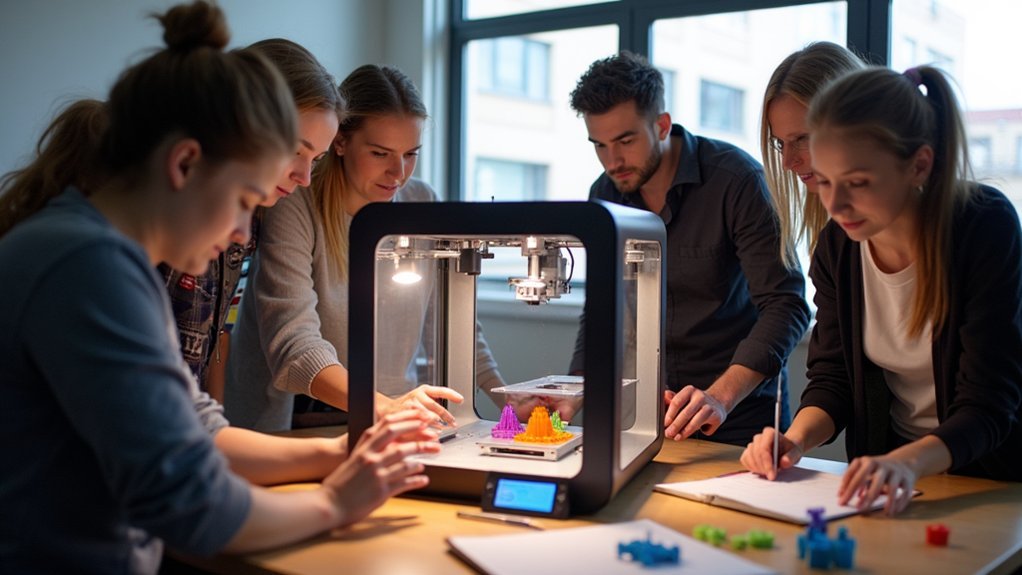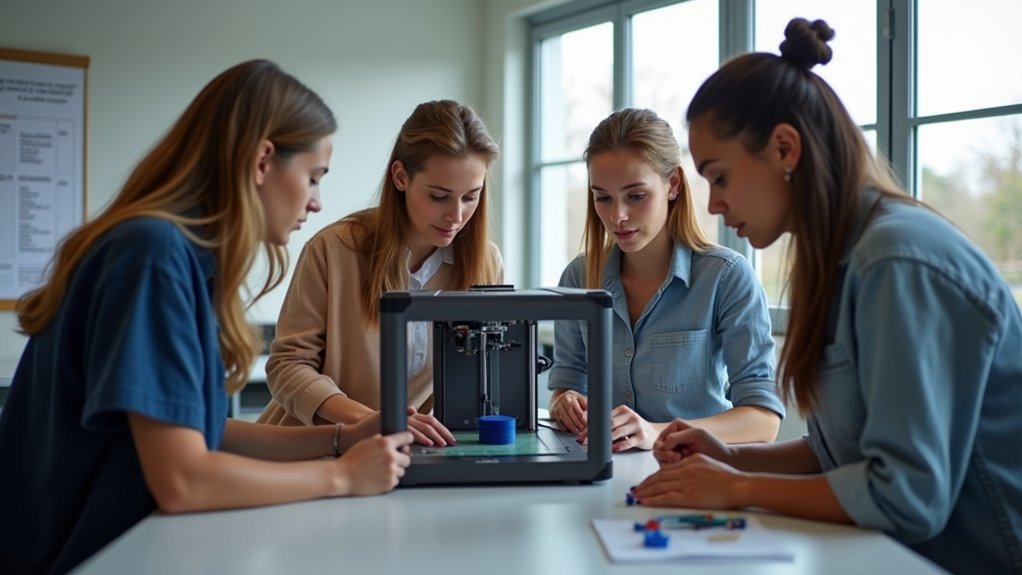You’ll want to start with hands-on workshops where teachers practice real maintenance scenarios like lubricating moving parts and calibrating print beds. Establish daily routines for cleaning with isopropyl alcohol, weekly calibration checks, and monthly deep cleaning schedules. Create safety protocols with proper PPE requirements and ventilation guidelines. Set up peer support networks and online platforms for sharing troubleshooting strategies. Document all maintenance activities to track performance patterns and build teacher confidence through collaborative learning experiences that guarantee long-term equipment success.
Understanding 3D Printer Components and Function

Knowledge forms the foundation of effective 3D printer maintenance, so you’ll need to understand how each component works before teaching others to maintain them.
Start by familiarizing yourself with the extruder, which feeds and melts filament for layer-by-layer deposition. You’ll also need to master print bed leveling and heating, as proper first-layer adhesion prevents warping and detachment issues that compromise print quality.
Mastering extruder operation and bed leveling creates the foundation for consistent first-layer adhesion and prevents common print failures.
The control board serves as the printer’s brain, interpreting GCode and managing movements and temperatures. Don’t overlook cooling fans, belts, and nozzles—these components directly impact performance.
Gaining a better understanding of how these parts interact enables you to teach thorough printer maintenance strategies that’ll keep classroom 3D printers running smoothly.
Essential Safety Protocols for Classroom Use
While 3D printers offer incredible educational opportunities, they also present unique safety challenges that require extensive protocols before teachers can confidently maintain these devices in classroom settings.
You’ll need to familiarize yourself with Material Safety Data Sheets for all filaments, understanding proper handling and storage procedures. Learning how to properly implement strict protocols for heated components means using heat-resistant gloves and protective eyewear during maintenance tasks.
Regular safety drills focusing on emergency shut-off procedures are vital. Keep your workspace clear of flammable materials and maintain an accessible electrical fire extinguisher.
Proper ventilation is important when certain plastics emit fumes during printing. Work with your team of experts to guarantee adequate airflow systems.
Additionally, master printer calibration procedures while maintaining these safety standards throughout all maintenance activities.
Daily Maintenance Routines for Teacher Implementation

You’ll establish consistent daily routines that keep your 3D printer running smoothly and prevent costly breakdowns.
These essential tasks include cleaning the print bed thoroughly, inspecting the nozzle for potential blockages, and checking your filament’s condition before each print session.
Print Bed Cleaning
Since print bed adhesion determines whether your 3D prints succeed or fail, establishing a consistent daily cleaning routine becomes your most critical maintenance task.
As a printer operator, you’ll need to clean the print bed with a lint-free cloth and isopropyl alcohol to remove residue and guarantee ideal adhesion. This print bed cleaning process helps you produce quality prints consistently.
After cleaning, inspect the surface for warping, damage, or leftover filament debris. A flat surface is essential for successful first layers.
Allow the bed to dry completely before starting new prints to prevent moisture-related adhesion issues.
Document your daily maintenance tasks to track printer performance and identify recurring problems. This systematic approach guarantees consistent print quality and reduces failures.
Nozzle Inspection Protocol
The nozzle serves as your 3D printer’s most vulnerable component, requiring daily inspection to prevent costly print failures and equipment damage. Your nozzle inspection routine should focus on identifying filament build-up and blockages that compromise print quality. Use a soft brush or compressed air to remove debris after each session.
| Inspection Step | Method | Documentation |
|---|---|---|
| Visual Check | Look for filament residue | Note blockage locations |
| Temperature Monitor | Verify correct heat settings | Record temperature issues |
| Cold Pull Test | Heat, feed, and extract filament | Track extraction results |
Monitor temperature settings closely, as incorrect values cause clogs from improper filament melting. Document all nozzle issues you encounter to establish maintenance trends that’ll inform your future troubleshooting strategies and keep your classroom printers running smoothly.
Filament Quality Checks
Proper filament storage and inspection directly impacts your print success rates and prevents costly material waste in classroom environments.
Daily filament quality checks guarantee consistent print quality while identifying issues before they affect student projects.
Follow these essential steps for effective filament inspection:
- Storage verification – Confirm filament’s stored in dry, temperature-controlled conditions to prevent moisture absorption.
- Visual damage assessment – Examine spools for cracks, breaks, or other physical damage that could cause nozzle clogs.
- Tangle detection – Gently unwind spools to check for tangles that disrupt feeding and cause under-extrusion.
- Issue documentation – Record any problems encountered to identify recurring patterns and improve material management.
These proactive checks prevent printing failures and help you maintain reliable classroom operations while extending filament lifespan.
Weekly Calibration and Inspection Tasks

While daily checks focus on immediate operational needs, weekly calibration and inspection tasks require you to dive deeper into your 3D printer’s mechanical systems.
During weekly maintenance, you’ll lubricate moving parts to reduce friction and extend component lifespan. Focus on calibrating the bed level using a piece of paper or feeler gauge – this guarantees consistent first layer adhesion that’s critical for successful prints.
Weekly lubrication and bed calibration form the foundation of reliable 3D printing performance and consistent first layer quality.
Don’t forget to tighten belts and screws, as loose hardware leads to misalignment and poor print quality. Always inspect for loose components like screws or connectors that could affect performance.
Keep a detailed log of all maintenance activities to track your printer’s condition and inform future troubleshooting efforts.
Monthly Deep Cleaning and Component Checks
Every four weeks, you’ll need to perform thorough deep cleaning and component checks that go beyond your routine maintenance tasks.
These monthly deep cleaning procedures are essential for maintaining your 3D printer’s ideal performance and preventing costly breakdowns.
Your extensive component checks should include:
- Disassemble the extruder to remove accumulated filament residue and inspect for wear or damage.
- Clean cooling fans thoroughly, removing dust build-up that can cause overheating issues.
- Inspect all electrical connections for worn or damaged wires that pose safety risks.
- Check belts and rods for wear, noting any components that’ll need annual replacement.
These monthly maintenance tasks help you identify potential problems early, ensuring your 3D printer continues delivering quality prints while extending its operational lifespan.
Troubleshooting Common Printer Issues
Three critical skills will transform your ability to diagnose and resolve 3D printer problems quickly: systematic observation, methodical testing, and understanding your printer’s feedback systems.
When troubleshooting, regularly inspect your nozzle for clogs or build-up that cause under-extrusion issues. Check bed adhesion by calibrating the print bed properly and examining for warping that creates first layer problems.
Learn essential GCode commands like M503 for printer settings and M104 for extruder temperature control. Always verify filament quality, checking for moisture and tangling that lead to inconsistent extrusion.
Master key GCode commands and monitor filament quality to prevent extrusion problems and maintain optimal 3D printing performance.
Monitor your printer running status through the terminal to identify issues during printing. These skills help you use a 3D printer effectively while maintaining consistent print quality and minimizing downtime.
Creating Student-Safe Maintenance Procedures
When students participate in 3D printer maintenance, you’ll need structured safety protocols that protect both your students and expensive equipment.
Student involvement offers students valuable hands-on experience while teaching responsibility and technical skills.
Create thorough procedures that guarantee students can safely take care of your 3D printing equipment:
- Establish clear safety guidelines with mandatory PPE requirements including gloves and safety goggles during all maintenance activities.
- Implement detailed checklists covering cleanliness protocols, proper component handling, and regular equipment inspections.
- Designate organized maintenance areas with proper ventilation, essential tools, and materials readily accessible.
- Develop reporting protocols requiring students to communicate any issues before attempting repairs.
These structured approaches help students understand that maintaining equipment is as vital as creating each digital model they design.
Developing School-Specific Maintenance Schedules
You’ll need to create a maintenance schedule that fits your school’s unique calendar and operational needs.
Start by establishing daily task assignments that teachers can easily complete between classes, then build weekly schedule planning around your heaviest 3D printer usage days.
Finally, implement monthly review protocols that help you assess what’s working and adjust your maintenance approach based on actual classroom conditions.
Daily Task Assignments
Establishing clear daily task assignments guarantees your school’s 3D printers receive consistent care and operate at peak performance.
When teachers know their specific responsibilities, you’ll prevent equipment failures that could disrupt students’ ability to create their next three-dimensional object.
Here’s how to structure effective daily assignments:
- Assign specific staff members to handle morning inspections, checking nozzles for filament buildup and confirming the print bed is level.
- Rotate cleaning responsibilities among teachers, focusing on isopropyl alcohol wipe-downs of print surfaces and removing any debris.
- Designate documentation duties to track maintenance performed and note any emerging issues in your logging system.
- Schedule reminder notifications through your school’s calendar system to prompt assigned teachers about their daily maintenance tasks.
This accountability system guarantees consistent printer upkeep.
Weekly Schedule Planning
Why leave weekly maintenance to chance when a structured schedule guarantees your 3D printers maintain peak performance throughout the academic year? You’ll need to develop a systematic approach that allocates specific days for each maintenance task, creating a routine that’s easy to follow.
Start by assigning different maintenance activities to specific weekdays. For example, schedule lubrication of moving parts on Mondays and bed calibration on Wednesdays. This prevents overwhelming teachers with multiple tasks on one day.
| Day | Maintenance Task |
|---|---|
| Monday | Lubricate moving parts |
| Wednesday | Calibrate print bed |
| Friday | Tighten belts and screws |
| Tuesday | Clean extruder nozzle |
| Thursday | Check filament quality |
Customize your schedule based on printer usage frequency, adjusting tasks to accommodate different activity levels and equipment wear.
Monthly Review Protocols
Since monthly maintenance requires more intensive procedures than your weekly tasks, implementing a detailed review protocol becomes crucial for preventing major equipment failures and costly repairs.
You’ll need to create a thorough school-specific maintenance schedule that clearly outlines each teacher’s responsibilities and timelines.
Your monthly review protocol should include:
- Deep cleaning the extruder and checking electrical connections for peak performance
- Inspecting cooling fans and replacing any worn components that could affect print quality
- Performing full calibration checks to maintain consistent results across all printers
- Organizing training sessions to guarantee every teacher understands proper maintenance execution
Remember to regularly review and update your schedule based on teacher feedback and printer performance, adapting to your school’s specific needs.
Building Teacher Confidence Through Hands-On Practice
Transforming theoretical knowledge into practical expertise requires teachers to roll up their sleeves and work directly with 3D printers. You’ll build confidence by tackling real maintenance scenarios through structured workshops that simulate common issues like clogged nozzles and bed adhesion problems.
| Maintenance Activity | Confidence Building Benefit |
|---|---|
| Lubricating moving parts | Familiarity with printer mechanics |
| Calibrating print bed | Enhanced problem-solving skills |
| Using GCode commands | Technical troubleshooting expertise |
| Following daily checklists | Systematic maintenance understanding |
| Documenting experiences | Collaborative learning reinforcement |
Regular hands-on practice with these maintenance tasks develops your technical skills while systematic checklists reinforce best practices. When you document your experiences and share insights with fellow educators, you’re creating a supportive community that strengthens everyone’s confidence in managing 3D printers effectively.
Setting Up Peer Support Networks Among Educators
While hands-on practice builds individual confidence, you’ll amplify your success by connecting with fellow educators who share similar challenges and experiences with 3D printer maintenance.
Creating effective peer support networks requires strategic planning and commitment:
Building meaningful peer support networks demands intentional effort and sustained dedication to creating lasting educational partnerships.
- Schedule regular meetings where you can exchange troubleshooting strategies, share best practices, and discuss common maintenance issues you’ve encountered.
- Establish online platforms like dedicated forums or social media groups for real-time assistance and ongoing resource sharing beyond scheduled meetings.
- Identify experienced mentors within your network who can provide hands-on guidance to less experienced teachers, building confidence through shared knowledge.
- Create feedback loops that allow your group to collectively evaluate maintenance strategies and tools, leading to continuous improvement in your practices.
Utilizing Digital Resources and Documentation Tools
Beyond building connections with colleagues, you’ll need robust digital resources and documentation tools that provide immediate access to maintenance guidance when challenges arise. Thorough training modules and PDF guides offer step-by-step instructions that guarantee clarity for complex maintenance tasks. Video tutorials enhance your learning by providing visual demonstrations you can follow alongside your own machine.
| Resource Type | Primary Benefit |
|---|---|
| Training Modules/PDFs | Step-by-step clarity |
| Video Tutorials | Visual demonstration |
| Centralized Documentation | Consistent practices |
A centralized documentation system gives you access to maintenance logs, checklists, and troubleshooting guides, fostering consistency across classrooms. Online forums enable collaborative problem-solving with other educators. Additionally, GCode console resources help you understand printer commands and monitor status, building your technical confidence and management skills.
Establishing Long-Term Equipment Care Strategies
You’ll maximize your 3D printers’ lifespan by implementing structured preventive care schedules that outline daily, weekly, monthly, and annual maintenance tasks.
Your equipment lifecycle planning should include tracking each printer’s usage hours, replacement part schedules, and performance metrics to predict when upgrades or replacements become necessary.
These long-term strategies help you budget effectively while ensuring your printers remain reliable throughout their operational life.
Preventive Care Schedules
When you establish a structured preventive care schedule, you’ll transform random maintenance efforts into a systematic approach that maximizes your 3D printer’s lifespan and performance.
Your preventive maintenance schedule should include these essential timeframes:
- Daily tasks – Clean the print bed and inspect the nozzle for blockages to prevent failed prints.
- Weekly maintenance – Lubricate moving parts and calibrate bed level for consistent quality.
- Monthly care – Deep clean the extruder and check cooling fans for ideal temperature control.
- Annual overhauls – Replace worn components and conduct thorough calibration checks.
You’ll want to implement a logging system that tracks each maintenance activity. This documentation helps you identify recurring issues and enables proactive care decisions.
Regular training sessions on these schedules enhance teachers’ understanding of maintenance requirements, ultimately improving print quality while reducing costly downtime.
Equipment Lifecycle Planning
While daily and weekly maintenance keeps your 3D printers running smoothly, strategic planning for their entire operational life guarantees you’ll maximize your educational investment.
You’ll need to assess each printer model’s expected lifespan—typically 5 to 10 years—to create effective replacement strategies.
Document every maintenance activity and technical issue you encounter. This records help you identify patterns that’ll inform future purchasing decisions and highlight specific training needs.
You should schedule regular maintenance checks, including lubrication and calibration, throughout each printer’s lifecycle to maximize performance.
Budget carefully for long-term equipment care, as maintenance costs can reach 20% of total ownership expenses.
Include equipment lifecycle planning in your professional development programs so you understand proactive maintenance’s importance and develop effective resource management skills.
Frequently Asked Questions
What Is the 45 Degree Rule for 3D Printing?
You should keep overhangs at 45 degrees or less from vertical when designing 3D models. This prevents sagging and reduces support material needs, improving print quality and success rates in FDM printing.
How Is 3D Printing Used in Teaching and Education?
You’ll enhance hands-on STEAM learning by creating tangible models and prototypes. Students develop critical thinking through design iterations while you provide customized materials for diverse learners, boosting engagement, collaboration, and spatial awareness across subjects.
How to Become a 3D Printer Technician?
You’ll need specialized training in printer setup, calibration, and maintenance. Learn GCode programming, gain hands-on experience with FDM, SLA, and SLS technologies, complete certification programs, and stay updated on latest advancements.
How Often Should You Do Maintenance on a 3D Printer?
You should perform daily maintenance like cleaning the print bed, weekly tasks including belt tightening and bed calibration, monthly deep cleaning of extruders, and annual component replacements for peak performance.





Leave a Reply